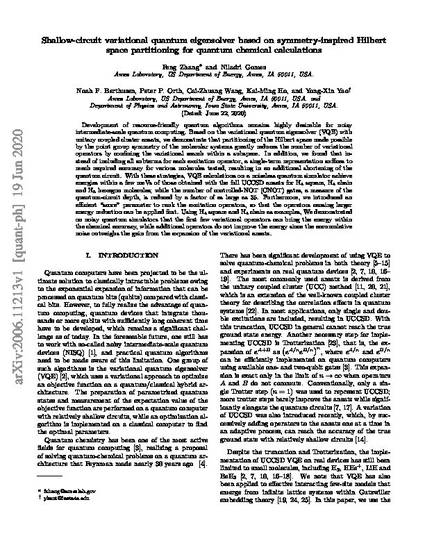
Development of resource-friendly quantum algorithms remains highly desirable for noisy intermediate-scale quantum computing. Based on the variational quantum eigensolver (VQE) with unitary coupled-cluster Ansatz, we demonstrate that partitioning of the Hilbert space made possible by the point-group symmetry of the molecular systems greatly reduces the number of variational operators by confining the variational search within a subspace. In addition, we found that instead of including all subterms for each excitation operator, a single-term representation suffices to reach required accuracy for various molecules tested, resulting in an additional shortening of the quantum circuit by a factor of 4–8. With these strategies, VQE calculations on a noise-free quantum simulator achieve energies within a few meVs of those obtained with the full unitary coupled-cluster Ansatz with single and double excitations for the H4-square, H4-chain, and H6-hexagon molecules, while the number of cnot gates, a measure of the quantum-circuit depth, is reduced by a factor of as large as 35. Furthermore, we introduced an efficient “score” parameter to rank the excitation operators, so that the operators causing larger energy reduction can be applied first. Using the H4 square and H4 chain as examples, We demonstrated on noisy quantum simulators that the first few variational operators can bring the energy within the chemical accuracy, while additional operators do not improve the energy since the accumulative noise outweighs the gain from the expansion of the variational Ansatz.
Available at: http://works.bepress.com/peter-orth/38/

This article is published as Zhang, Feng, Niladri Gomes, Noah F. Berthusen, Peter P. Orth, Cai-Zhuang Wang, Kai-Ming Ho, and Yong-Xin Yao. "Shallow-circuit variational quantum eigensolver based on symmetry-inspired Hilbert space partitioning for quantum chemical calculations." Physical Review Research 3, no. 1 (2021): 013039. DOI: 10.1103/PhysRevResearch.3.013039. Posted with permission.